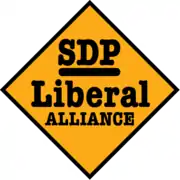| |||||||||||||||||||||||||||||||||
All 32 London boroughs, all 36 metropolitan boroughs, 103 out of 296 English districts and all 12 Scottish regions | |||||||||||||||||||||||||||||||||
|---|---|---|---|---|---|---|---|---|---|---|---|---|---|---|---|---|---|---|---|---|---|---|---|---|---|---|---|---|---|---|---|---|---|
| |||||||||||||||||||||||||||||||||
Local elections were held in the United Kingdom in 1982.[1][2] The elections coincided with rising popularity of the Conservative government and Prime Minister Margaret Thatcher, which was mostly attributed to the Falklands War. The projected share of the vote was Conservatives 40%, Labour 29%, Liberal-SDP Alliance 27%.
Elections were held in several English boroughs, including all those in London.
The Conservatives held their ground, losing only 98 seats, leaving them with 10,447 seats.
The main opposition Labour Party, under the leadership of Michael Foot, lost 225 seats, finishing with 8,774 councillors.
For the newly formed Liberal-SDP Alliance, the 1982 local elections were the first annual electoral test. They gained 395 seats and finished with 1,850 councillors. This meant that the Alliance had almost as many votes as Labour, but Labour still had nearly five times as many councillors.
Summary of results
England
London boroughs
In all 32 London boroughs the whole council was up for election.
‡ New ward boundaries
Metropolitan boroughs
Whole council
In 13 metropolitan boroughs the whole council was up for election.
In 13 boroughs there were new ward boundaries, following electoral boundary reviews by the Local Government Boundary Commission for England.
| Council | Previous control | Result | Details | ||
|---|---|---|---|---|---|
| Birmingham ‡ | Labour | Conservative gain | Details | ||
| Dudley ‡ | No overall control | Conservative gain | Details | ||
| Gateshead ‡ | Labour | Labour hold | Details | ||
| Kirklees ‡ | Labour | Labour hold | Details | ||
| Knowsley ‡ | Labour | Labour hold | Details | ||
| Manchester ‡ | Labour | Labour hold | Details | ||
| Newcastle upon Tyne ‡ | Labour | Labour hold | Details | ||
| North Tyneside ‡ | Labour | Labour hold | Details | ||
| Salford ‡ | Labour | Labour hold | Details | ||
| South Tyneside ‡ | Labour | Labour hold | Details | ||
| Sunderland ‡ | Labour | Labour hold | Details | ||
| Wakefield ‡ | Labour | Labour hold | Details | ||
| Wolverhampton ‡ | Labour | Labour hold | Details | ||
‡ New ward boundaries
Third of council
23 metropolitan borough councils had one third of their seats up for election.
District councils
In 103 districts one third of the council was up for election.
Scotland
Regional councils
| Council | Previous control | Result | Details | ||
|---|---|---|---|---|---|
| Borders | Independent | Independent hold | Details | ||
| Central | Labour | Labour hold | Details | ||
| Dumfries and Galloway | Independent | Independent hold | Details | ||
| Fife | Labour | Labour hold | Details | ||
| Grampian | Conservative | Conservative hold | Details | ||
| Highland | Independent | Independent hold | Details | ||
| Lothian | Labour | No overall control gain | Details | ||
| Orkney | Independent | Independent hold | Details | ||
| Shetland | Independent | Independent hold | Details | ||
| Strathclyde | Labour | Labour hold | Details | ||
| Tayside | Conservative | Conservative hold | Details | ||
| Western Isles | Independent | Independent hold | Details | ||
References
- ↑ Rallings, Colin; Thrasher, Michael. Local Elections Handbook 1982. The Elections Centre. Retrieved 3 May 2016.
- ↑ "Council compositions". The Elections Centre. Retrieved 3 May 2016.
.jpg.webp)
.jpg.webp)
